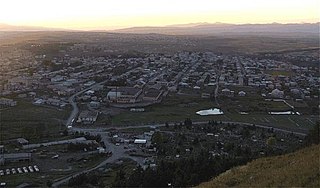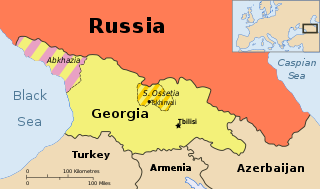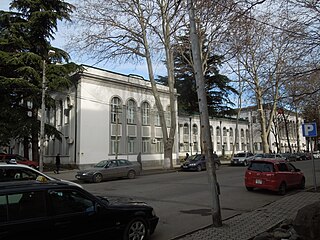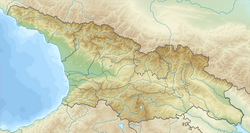
The Democratic Republic of Georgia was the first modern establishment of a republic of Georgia, which existed from May 1918 through February 1921. Recognized by all major European powers of the time, DRG was created in the wake of the Russian Revolution of 1917, which led to the collapse of the Russian Empire and allowed territories formerly under Saint Petersburg's rule to assert independence. In contrast to Bolshevik Russia, DRG was governed by a moderate, multi-party political system led by the Georgian Social Democratic Party (Menshevik).

Gori is a city in eastern Georgia, which serves as the regional capital of Shida Kartli and is located at the confluence of two rivers, the Mtkvari and the Liakhvi. Gori is fifth-most populous city in Georgia. The name comes from a Georgian word gora (გორა), meaning "heap", or "hill", or a mountain.

Syunik is the southernmost province of Armenia. It is bordered by the Vayots Dzor Province to the north, Azerbaijan's Nakhchivan Autonomous Republic exclave to the west, Azerbaijan to the east, and Iran to the south. Its capital and largest city is the town of Kapan. The Statistical Committee of Armenia reported its population was 141,771 in the 2011 census, down from 152,684 at the 2001 census.

Shida Kartli is a landlocked administrative region (Mkhare) in eastern Georgia. It comprises a central part of the historical-geographic province of Shida Kartli. With an area of 5,729 square kilometres (2,212 sq mi), Shida Kartli is the 8th largest Georgian region by land area. With 284,081 inhabitants, it is Georgia's seventh-most-populous region. Shida Kartli's capital and largest city, Gori, is the 5th largest city in Georgia.

Georgia Tbilisi TV Broadcasting Tower is a free-standing tower structure used for communications purposes. The tower is located in Tbilisi, Georgia and was built in 1972. The preceding structure, built in 1955, was moved to the vicinity of the city of Gori.

Akhalkalaki is a town in Georgia's southern region of Samtskhe–Javakheti and the administrative centre of the Akhalkalaki Municipality. Akhalkalaki lies on the edge of the Javakheti Plateau. The city is located about 30 kilometres (19 mi) from the border with Turkey. The town's recorded history goes back to the 11th century. As of the 2014 Georgian census the town had a population of 8,295, with 93.8% Armenian majority.

Gori is a district of Georgia, in the region of Shida Kartli. After abolishment of former South Ossetian Autonomous Oblast, the Gori District included the territory of former Tskhinvali District. Some northern territories of the district are part of a self-proclaimed republic of South Ossetia and have not been under control of the Georgian government since 1992. It is bordered by the municipalities of Kaspi to the east, Borjomi and Tsalka to the south, and Kareli to the west. The area of Gori municipality is 1352 km2 and the population is 125,692 people. The administrative center of the municipality is the city of Gori.

Gori Fortress is a medieval citadel in Georgia, situated above the city of Gori on a rocky hill.

The Russo-Georgian War was a war between Georgia, on one side, and Russia and the Russian-backed self-proclaimed republics of South Ossetia and Abkhazia, on the other. The war took place in August 2008 following a period of worsening relations between Russia and Georgia, both formerly constituent republics of the Soviet Union. The fighting took place in the strategically important South Caucasus region. It is regarded as the first European war of the 21st century.

The Russo-Georgian War broke out in August 2008 and involved Georgia, Russian Federation, South Ossetia and Abkhazia.

European Route E 117 is part of the International E-road network, which is a series of main roads in Europe.
The Occupation of Gori was the military occupation of Gori and its surrounding areas by Russian military forces, which started on 13 August 2008 as part of the Russo-Georgian War, and ended with the withdrawal of Russian units from the city on 22 August 2008.

Gori State Teaching University is a center for education and science in Shida Kartli in the Gori Municipality of Georgia, it was established as a result of merging of two high education institutions: Gori State University and Tskhinvali State University.

Mate Vatsadze is Georgian football player who plays for Gagra.

Gori City Hall is an administrative building of Gori, Georgia, a city in eastern Georgia, which serves as the regional capital of Shida Kartli.
The 2011–12 Georgian Cup was the sixty-eighth season overall and the twenty-second since independence of the Georgian annual football tournament. The competition began on 17 August 2011 and ended with the final in May 2012. The defending champions were Gagra. The winner of the competition, Dila Gori, qualified for the second qualifying round of the 2012–13 UEFA Europa League.
The 1931 Zangezur earthquake occurred on April 27 at with a moment magnitude of 6.5. The earthquake was located in the Zangezur Mountains near the boundary between southwestern Armenia and Azerbaijan's exclave, the Nakhichivan Autonomous Republic. Both territories were part of the Soviet Union at that time.
The 2013–14 Georgian Cup is the seventieth season overall and the twenty-fourth since independence of the Georgian annual football tournament. The competition began on 21 August 2013 and will end with the final in May 2014. The defending champions are Dinamo Tbilisi, after winning their tenth ever Georgian Cup last season. The winner of the competition will qualify for the second qualifying round of the 2014–15 UEFA Europa League.

The Ruisi cathedral of the Mother of God is a Georgian Orthodox church in the village of Ruisi in Georgia's east-central Shida Kartli region. Originally built in the 8th–9th century, the church was remodeled in the 11th century and rebuilt in the 15th century. It is a cross-in-square church with a tall dome and a horseshoe apse on the east. The cathedral is inscribed on the list of Georgia's Immovable Cultural Monuments of National Significance.















